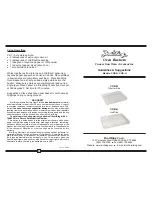
ZR TREMOLO
The ZR Tremolo is a double locking tremolo featuring the Zero Point System that keeps
the tremolo unit flat (at the zero point). This system eliminates the hassle of tuning, which
is a shortcoming of a floating tremolo, providing a more comfortable playing experience.
Furthermore, the supporting point is equipped with a high-precision built-in ball bearing,
which realizes smooth arming.
Attaching the tremolo arm
The tremolo arm is a plug-in type with a torque adjustment cap incorporated into the arm
unit. Insert the tremolo arm into the arm socket of the base plate, and then tighten the
torque adjustment cap (Fig. 1) to fix the tremolo arm in place. You can adjust the tremolo
arm torque by tightening/loosening the torque adjustment cap. Turning the cap clockwise
will tighten the arm torque, and turning it counterclockwise will loosen the arm torque.
Adjusting tremolo angle and Zero Point System
The angle of the tremolo is adjusted by the balance between the tension of the strings
and the zero point system installed on the back side of the guitar body. The ZR tremolo
is designed so that by correctly adjusting the Zero Point System, the tremolo unit sits
roughly parallel to the surface of the guitar body. This ensures optimal performance. Tun-
ing is completed when the Zero Point System is adjusted to the correct position. If the
tremolo is roughly parallel to the surface of the body, the stop rod contacts the tremolo
block and the stopper.
To adjust the angle of the tremolo, turn the spring adjustment knob (Fig. 2 A) on the back
side of the guitar. If the stop rod (Fig. 3 B) does not contact the stopper (Fig. 3 C) (or the
tremolo is tilted forward) when the guitar is correctly tuned, turn the spring adjustment
knob clockwise to tighten the spring. If the tremolo block (Fig. 3 D) does not contact the
stop rod (or the tremolo is tilted backward), turn the spring adjustment knob counter-
clockwise to loosen the spring.
Using as a floating tremolo (Zero Point System deactivated)
The ZR tremolo can also be used as a normal floating tremolo by deactivating the Zero
Point System. While holding the arm up (with the tremolo block facing away from the
stop rod), remove the stop rod (Fig. 3 B) and sub spring (Fig. 4 E). Adjust the angle of
the tremolo that is in a floating state by adjusting the balance between the tension of
the strings and the tension of the tremolo springs installed on the back side of the guitar
body. Setting the tremolo so that it is approximately parallel to the surface of the guitar
body will ensure optimal performance. To adjust the angle of the tremolo, turn the spring
adjustment knob (Fig. 2 A) on the back side of the guitar. If the tremolo is tilted forward
while the guitar correctly tuned, turn the spring adjustment knob clockwise to tighten the
spring. If the tremolo is tilted backward, turn the spring adjustment knob counterclock-
wise to loosen the spring.
When adjusting the tremolo angle that is in a floating state, the balance between the ten-
sion of the strings and the tension of the tremolo springs changes each time the tension
of the spring is adjusted, Thus, adjustments should affect tuning. Make adjustments by
tuning the strings repeatedly.
Fig. 1
A
Fig. 2
D
B
C
Fig. 3
E
Fig. 4
Содержание AEL Series AEL10E
Страница 1: ......




































